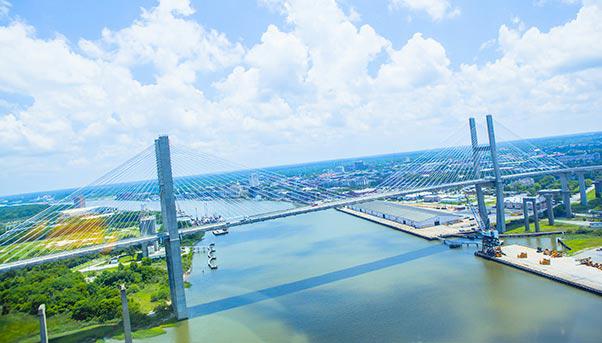
The road connecting the port of Savannah to Atlanta unfolds slowly, crossing endless forests and cultivated fields. There’s a sense of suspended time that only Southern states are able to evoke. The road was built along with the railway to carry goods from the port, the largest in the United States and one of the busiest in the world. It opens the way to continental America, towards the Midwest and up to the Great Lakes cities: Chicago, Detroit, Cleveland. It also works the opposite way from the heavy industry of the Rust Belt to the Atlantic and onwards to South America and Europe.
It is one of the most important arteries of the United States. After the financial crisis of 2008, the economy has taken off again, creating jobs and bringing the country back to full employment.
Since the beginning of the 20th century, Georgia and its infrastructure network have been a fundamental part of the economy. Not surprisingly, Atlanta became home to the “New South”, a school of thought that reshaped the Southern states, helping them shift from an economic model based on slavery and agriculture to an industrial one, similar to the adopted by the Northern states.
In order to support this project, bridges, roads, railroads, and aqueducts were built. Eventually, the port of Savannah became central to the country. Meanwhile, Georgia became the Empire State of the South, the most common title after the Peach State in light of to the endless peach plantations that extend from the capital, Atlanta, to the center of the state. As for Atlanta, it acts as Georgia’s brains: a city of five million people spread across a territory that makes it the most extended metropolitan area in the country, ahead of New York, Los Angeles and Chicago. It is also home to Coca Cola, Delta Airlines, CNN and Home Depot.
In one ranking produced by the television network CNBC, Georgia’s infrastructure is among the best in the United States, following Texas, Tennessee and Indiana. This is thanks to Savannah, which has the largest container terminal in North America, as well as the Hartsfield-Jackson airport in Atlanta, one of the busiest in the world.
Sung-Hee Sonny Kim, an associate professor of civil engineering at the University of Georgia, says more investment in infrastructure is nevertheless needed in the state just like everywhere else in the United States. «Right now there is a lack of investment in infrastructure. However, the money provided by the state and the federal agency for transportation helps a lot to solve this problem,» says Kim, who is working with the Georgia Department of Transportation to build roads that can endure weather and the intensification of hurricanes.

A report by the American Society of Civil Engineers (ASCE) on the poor state of infrastructure in the country estimates that the delay in modernizing it will cost each U.S. citizen $912 by 2020, compared with $130 in 2010 a year. By 2040, the cost may triple from the levels of 2020. «I believe that investments to keep infrastructure compatible with the environment and resilient to multiple risks, both in urban and coastal areas, can improve the state of infrastructure itself,» says Kim, adding that technology will be fundamental to improve it.
Bridges are one of Georgia’s weak spots. There are more than 14,000 of them, some historic and beautiful like the Red Oak Creek in Woodbury that still carried the wooden roof. There are more recent versions but they all have maintenance problems. According to Russell McMurry, head of the Department of Transportation of Georgia, the average age of state bridges is 43 years, but most of them were built to last 50 years. About 20% of Interstate roads and 26% of national roads are in «poor or severe condition», while 18% of local roads and bridges are «obsolete», said McMurry in a speech at the Transportation Summit held at the end of November in Athens, a small town not too far from Atlanta.
Of course, there are many positives to highlight. According to ASCE, the general level of infrastructure in Georgia corresponds to a C grade against a D for the national average. Along the coast, from Savannah to Jacksonville in Florida, signs of Hurricane Matthew are still visible: 30% of the beaches have been eroded by the ocean. «In the past, the state and federal and local authorities found a way to support the vital demand for infrastructure. Anyhow, I hope to enable the foundation of a decision-making unit in order to bring the U.S. into the 22nd century of transportation,» Kim says.
Apparently, there is enough money to pursue this objective. At the state level, Georgia has assigned $1 billion for projects related to transportation and communication, McMurry says. At the same time, the FAST Act signed by President Barack Obama in 2015 plans to provide $1.3 billion in federal funds, even though there are so far only $250 million available. Then there is Donald Trump’s plan. During his election campaign, the president-elect reiterated his willingness to revive the economy by investing $1 trillion in new roads, bridges, tunnels and ports.


